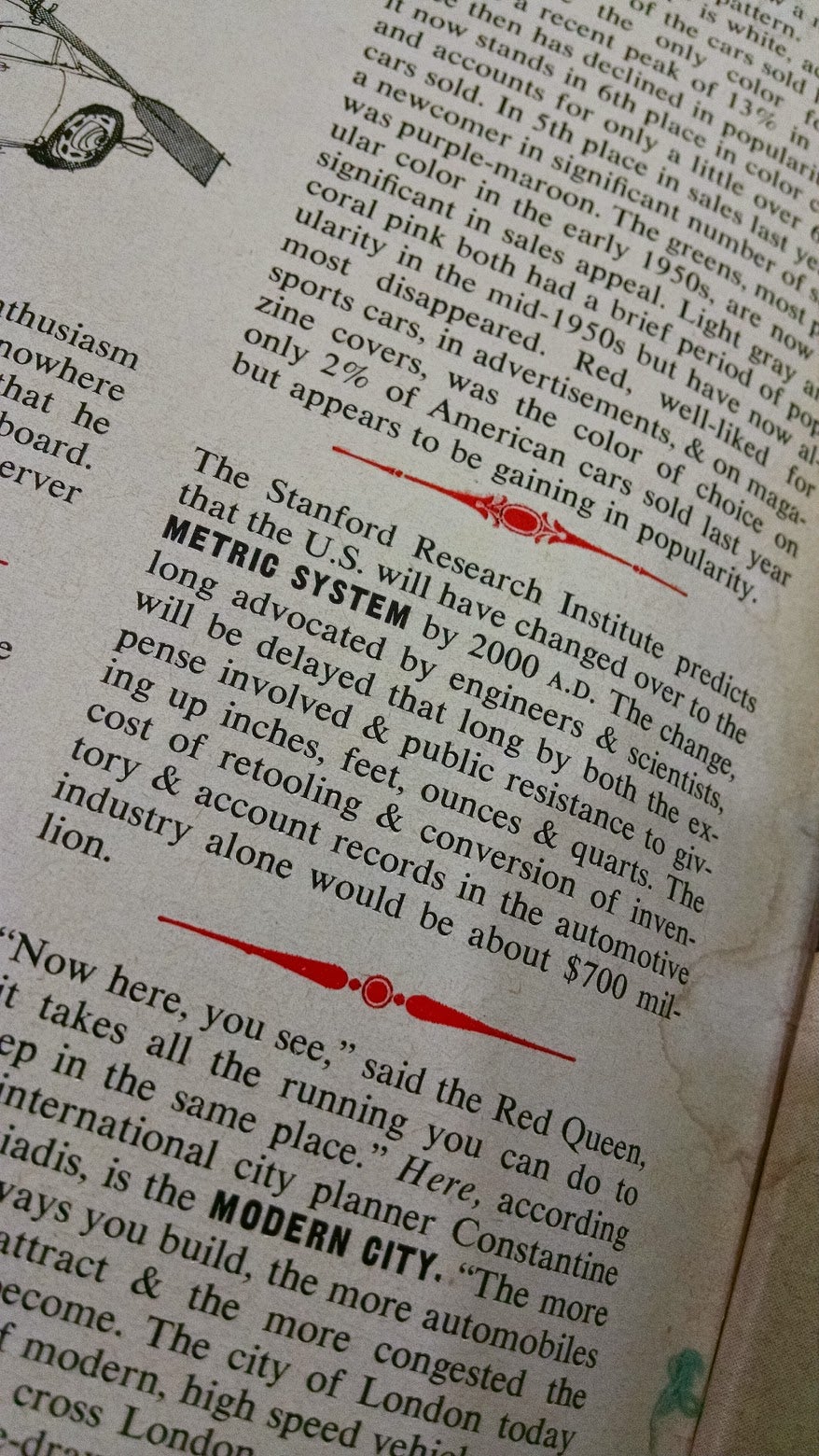 "Josh G" (kerbhopping)
"Josh G" (kerbhopping)
05/12/2015 at 12:17 • Filed to: From the Archives
 2
2
 15
15
 "Josh G" (kerbhopping)
"Josh G" (kerbhopping)
05/12/2015 at 12:17 • Filed to: From the Archives |  2 2
|  15 15 |
!!! UNKNOWN CONTENT TYPE !!!
Only a couple years after this 1961 letter claiming metric=communist plot to destroy America, Stanford made this prediction:
The Stanford Research Institute predicts that the U.S. will have changed over to the
METRIC SYSTEM
by 2000 A.D. The change, long advocated by engineers & scientists, will be delayed that long by both the expense involved & public resistance to giving up inches, feet, ounces & quarts. The cost of retooling & conversion of inventory & account records in the automotive industry alone would be about $700 million.
R&T 1963

 For Sweden
> Josh G
For Sweden
> Josh G
05/12/2015 at 12:20 |
|
Considering the Anglo Homeland still uses stone, this change won’t happen for a while. And as all units are arbitrary anyway, that’s OK.
 RamblinRover Luxury-Yacht
> For Sweden
RamblinRover Luxury-Yacht
> For Sweden
05/12/2015 at 12:26 |
|
That’s the precise point, really. Unless calculations are involved, the units in use depend on both “feel” in everyday use and familiarity and are otherwise arbitrary. Any extra burden to calculations in imperial is offset (in modern times) by computing availability and (on the workman’s level) by straightforwardness in fractions and industry use of inch thousandths.
 Will with a W8 races an E30
> Josh G
Will with a W8 races an E30
> Josh G
05/12/2015 at 12:31 |
|
Funny, most of the auto industry has converted. Are there any OEMs still using imperial units regularly?
 Josh G
> RamblinRover Luxury-Yacht
Josh G
> RamblinRover Luxury-Yacht
05/12/2015 at 12:34 |
|
Growing up in and around a precision manufacturing facility I always saw imperial represented with three decimals so I never saw a huge desire to change. I also never understood the irrational fear of the metric system.
 RamblinRover Luxury-Yacht
> Josh G
RamblinRover Luxury-Yacht
> Josh G
05/12/2015 at 12:35 |
|

I also note that as far back as ‘63, R&T was engaging in the Unlimited Field of Dreams fallacy. If-you-build-it-they-will-come with no consideration to what capacity actually means - a release of an untapped potential and not (past a point) a generation of it. “What’s the point of building more roads - they’ll only attract more cars and fill to capacity, so the best thing is fewer roads!” has been a canard for a very long time, but it’s not tautological in any way and in some respects reverses cause and effect.
 RamblinRover Luxury-Yacht
> Will with a W8 races an E30
RamblinRover Luxury-Yacht
> Will with a W8 races an E30
05/12/2015 at 12:39 |
|
Many businesses that don’t do international trade on a large scale are very much still in the Imperial business. Small engine manufacturers, for example. OEM *auto* makers, probably not, but that has a lot to do with global supply chains. There were (through quirks of production) inch fasteners in some Land Rovers all the way up to the 2000s and some Jags into the 90s on specific parts. Construction and industrial equipment still sees a lot of SAE fasteners as well, majority in some disciplines. I work at a company that provides a specific kind of specialty equipment worldwide, and the vast majority of our fasteners used are inch.
 Josh G
> Will with a W8 races an E30
Josh G
> Will with a W8 races an E30
05/12/2015 at 12:40 |
|
I remember working on a Ford in the 90’s that I believe had a little of both, that was frustrating.
 RamblinRover Luxury-Yacht
> Josh G
RamblinRover Luxury-Yacht
> Josh G
05/12/2015 at 12:45 |
|
I don’t think it was irrational fear of the metric system so much as rational or irrational fear of its advocates. “HERE, CHANGE TO METRIC BECAUSE IT’S BETTER” - said many, many people who don’t understand how measuring systems work. Conversion efforts imposed from above have always had a whiff of that particular sub-strain of progressivism that seeks to engineer “the stupids” who “don’t know what’s best for them”, and in the case of fastener standards, the people on the ground actually *are* in a position to know what’s best for them (or at least not unalloyed “better” for them), thank you. I personally would hold that anyone seeking to change a thing without understanding it in search of some nebulous good they don’t understand either can rightly fuck off, but that’s a matter of taste. A Metric Evangelist is a nut, full stop.
 Josh G
> RamblinRover Luxury-Yacht
Josh G
> RamblinRover Luxury-Yacht
05/12/2015 at 12:47 |
|
Interesting counterpoint, under what I believe was the same editor, only two years earlier R&T published cover story was Victor Gruen’s Our Enemy The Automobile. I will try and share more about this soon... ‘real work’ is calling my name.
 RamblinRover Luxury-Yacht
> Josh G
RamblinRover Luxury-Yacht
> Josh G
05/12/2015 at 12:49 |
|
To be fair, the fallacy sort of holds steady (for the wrong reasons) if population continues to grow without bound or altered rate, but recent history indicates that Malthus really wasn’t all that...
 Will with a W8 races an E30
> Josh G
Will with a W8 races an E30
> Josh G
05/12/2015 at 12:52 |
|
Ford is completely changed over for sure, I assume FCA as well given that all parts have been at least owned by Eurpeans for a while. Not sure about GM.
 Will with a W8 races an E30
> RamblinRover Luxury-Yacht
Will with a W8 races an E30
> RamblinRover Luxury-Yacht
05/12/2015 at 12:55 |
|
Plenty of non-OEM automotive stuff (in racing, for example) is still imperial, simply due to parts availability. Compare McMaster-Carr’s metric and imperial fastener selections and it makes perfect sense. Now if only we could narrow fluid lines and fittings to two competing standards....
 RamblinRover Luxury-Yacht
> Will with a W8 races an E30
RamblinRover Luxury-Yacht
> Will with a W8 races an E30
05/12/2015 at 13:04 |
|
An interesting note there, actually. My cousin’s Cobalt SS, an ‘09, I believe, has a factory upgrade Brembo setup. At least, the calipers on front are Brembo, and the rear are GM-branded. The bleed screws on the Brembo calipers are a different size than the rear GM ones - and possibly inch! While Brembo is an Italian company, I believe most US market parts are manufactured stateside, and supply chains being what they are...
That, at least, is *a* way inch parts can sneak in. A further note - old Land Rover brake systems use relieved tip tubing nuts like metric, but with an inch thread, so most of the time you have to order lines, or you’re boned. The oil pressure gauge uses some half-forgotten British non-tapered pipe standard...
 B/Xmrrmvr
> Josh G
B/Xmrrmvr
> Josh G
05/12/2015 at 13:45 |
|
en.wikipedia.org/wiki/Metric_Conversion_Act
 Josh G
> RamblinRover Luxury-Yacht
Josh G
> RamblinRover Luxury-Yacht
05/12/2015 at 17:48 |
|
I was digging through the tap draw recently and found a straight british pipe tap. Probably 80 years old, I left it for someone else to ponder.